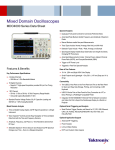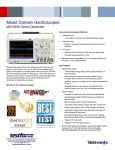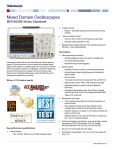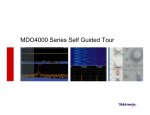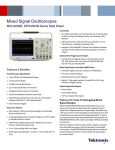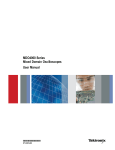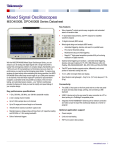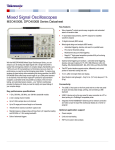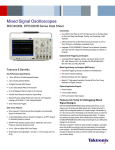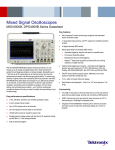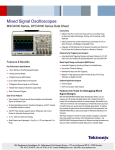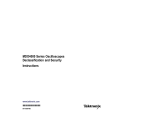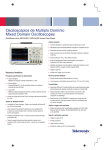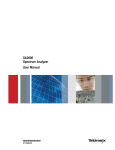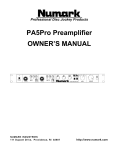Download Mixed Domain Oscilloscope
Transcript
Mixed Domain Oscilloscopes MDO4000 Series Datasheet Key performance specifications 4 analog channels 1 GHz, 500 MHz, 350 MHz, and 100 MHz bandwidth models 16 digital channels MagniVu™ high-speed acquisition provides 60.6 ps fine timing resolution 1 spectrum analyzer channel 50 kHz to 3 GHz or 50 kHz to 6 GHz frequency range models Ultra-wide capture bandwidth ≥1 GHz Standard passive voltage probes with 3.9 pF capacitive loading and 500 MHz or 1 GHz analog bandwidth Introducing the world's first and only oscilloscope with a built-in spectrum analyzer. For the first time ever, you can capture time-correlated analog, digital, and RF signals for a complete system view of your device. See both the time and frequency domain in a single glance. View the RF spectrum at any point in time to see how it changes over time or with device state. Solve the most complicated design issues, quickly and efficiently, with an oscilloscope as integrated as your design. Winner of 13 industry awards Key features Spectral analysis Dedicated front-panel controls for commonly performed tasks Automated peak markers identify frequency and amplitude of spectrum peaks Manual markers enable non-peak measurements Trace types Include: Normal, Average, Max Hold, and Min Hold Detection types include: +Peak, -Peak, Average, and Sample Spectrogram display enables easy observation and insight into slowly changing RF phenomena Automated measurements include: Channel Power, Adjacent Channel Power Ratio (ACPR), and Occupied Bandwidth (OBW) Trigger on RF power level Triggered or Free Run spectral analysis Mixed-domain analysis Time-correlated analog, digital, and RF signal acquisitions in a single instrument Wave Inspector® controls provide easy navigation of timecorrelated data from both the time and frequency domains Amplitude, frequency, and phase vs. time waveforms derived from spectrum analyzer input Selectable spectrum time to discover and analyze how RF spectrum changes over time - even on a stopped acquisition Optional serial triggering and analysis - serial protocol trigger, decode, and search for I2C, SPI, USB, Ethernet, CAN, LIN, FlexRay, RS-232/422/485/UART, MIL-STD-1553, and I2S/LJ/RJ/TDM Datasheet 264 mm (10.4 inches) bright XGA color display Small footprint and lightweight - Only 147 mm (5.8 inches) deep and 5 kg (11 lb.) Connectivity The spectrum shown in the Frequency Domain view is taken from the period of time indicated by the short orange bar in the time domain view – known as the Spectrum Time. With the MDO4000 Series, Spectrum Time can be moved through the acquisition to investigate how the RF spectrum changes over time. And this can be done while the oscilloscope is live and running or on a stopped acquisition. Two USB 2.0 host ports on the front panel and two on the rear panel for quick and easy data storage, printing, and connecting a USB keyboard USB 2.0 device port on the rear panel for easy connection to a PC or direct printing to a PictBridge®-compatible printer Integrated 10/100/1000BASE-T Ethernet port for network connection and video out port to export the oscilloscope display to a monitor or projector Optional application support Advanced RF triggering Power analysis Limit and mask testing HDTV and custom video analysis Introducing the Mixed Domain Oscilloscope The MDO4000 Series is the world's first oscilloscope with a built in spectrum analyzer. This integration enables you to continue to use your debug tool of choice, the oscilloscope, to investigate frequency domain issues rather than having to find and re-learn a spectrum analyzer. However, the power of the MDO4000 Series goes well beyond simply observing the frequency domain as you would on a spectrum analyzer. The real power is in its ability to correlate events in the frequency domain with the time domain phenomena that caused them. When both the spectrum analyzer and any analog or digital channels are on, the oscilloscope display is split into two views. The upper half of the display is a traditional oscilloscope view of the Time Domain. The lower half of the display is a Frequency Domain view of the spectrum analyzer input. Note that the Frequency Domain view is not simply an FFT of the analog or digital channels in the instrument, but is the spectrum acquired from the spectrum analyzer input. Another key difference is that with traditional oscilloscope FFTs, you can typically either get the desired view of the FFT display, or the desired view of your other time domain signals of interest, but never both at the same time. This is because traditional oscilloscopes only have a single acquisition system with a single set of user settings such as record length, sample rate, and time per division that drive all data views. But with the MDO4000 Series, the spectrum analyzer has its own acquisition system that is independent, but time correlated, to the analog and digital channel acquisition systems. This allows each domain to be configured optimally, providing a complete time correlated system view of all analog, digital, and RF signals of interest. 2 www.tektronix.com The upper half of the MDO4000 Series display shows the Time Domain view of the analog and digital channels, while the lower half shows the Frequency Domain view of the spectrum analyzer channel. The orange bar - Spectrum Time - shows the period of time used to calculate the RF spectrum. Figures 1 through 4 show a simple everyday application – tuning of a PLL. This application illustrates the powerful connection between the time domain and the frequency domain that the MDO4000 Series provides. With its wide capture bandwidth and ability to move Spectrum Time throughout the acquisition, this single capture includes the same spectral content as approximately 1,500 unique test setups and acquisitions on a traditional spectrum analyzer. For the first time ever, correlating events, observing interactions, or measuring timing latencies between the two domains is exceptionally easy, giving you quick insight to your design’s operation. Mixed Domain Oscilloscopes — MDO4000 Series Figure 1 - Time and Frequency Domain view showing the turn-on of a PLL. Channel 1 (yellow) is probing a control signal that enables the VCO. Channel 2 (cyan) is probing the VCO tune voltage. The SPI bus which is programming the PLL with the desired frequency is probed with three digital channels and automatically decoded. Notice Spectrum Time is placed after the VCO was enabled and coincident with the command on the SPI bus telling the PLL the desired frequency of 2.400 GHz. Note that the RF is at 2.2202 GHz when the circuit turns on. Figure 3 - Spectrum Time is moved another 120 μs to the right. At this point the spectrum shows that the PLL has actually overshot the correct frequency and gone all the way to 2.4164 GHz. Figure 4 - The PLL eventually settles on the correct 2.400 GHz frequency about 340 μs after the VCO was enabled. Figure 2 - Spectrum Time is moved about 60 μs to the right. At this point, the spectrum shows that the PLL is in the process of tuning to the correct frequency (2.400 GHz). It has made it up to 2.3168 GHz. www.tektronix.com 3 Datasheet Visualizing changes in your RF signal The time domain graticule on the MDO4000 Series display provides support for three RF time domain traces that are derived from the underlying I and Q data of the spectrum analyzer input including: Amplitude - The instantaneous amplitude of the spectrum analyzer input vs. time Frequency - The instantaneous frequency of the spectrum analyzer input, relative to the center frequency vs. time Phase - The instantaneous phase of the spectrum analyzer input, relative to the center frequency vs. time Each of these traces may be turned on and off independently, and all three may be displayed simultaneously. RF time domain traces make it easy to understand what's happening with a time-varying RF signal. Advanced triggering with analog, digital and spectrum analyzer channels In order to deal with the time-varying nature of modern RF applications, the MDO4000 Series provides a triggered acquisition system that is fully integrated with the analog, digital and spectrum analyzer channels. This means that a single trigger event coordinates acquisition across all channels, allowing you to capture a spectrum at the precise point in time where an interesting time domain event is occurring. A comprehensive set of time domain triggers are available, including Edge, Sequence, Pulse Width, Timeout, Runt, Logic, Setup/Hold Violation, Rise/Fall Time, Video, and a variety of parallel and serial bus packet triggers. In addition, you can trigger on the power level of the spectrum analyzer input. For example, you can trigger on your RF transmitter turning on. The optional MDO4TRIG application module provides advanced RF triggering. This module enables the RF power level on the spectrum analyzer to be used as a source for Sequence, Pulse Width, Timeout, Runt, and Logic trigger types. For example, you can trigger on a RF pulse of a specific length or use the spectrum analyzer channel as an input to a logic trigger, enabling the oscilloscope to trigger only when the RF is on while other signals are active. Fast and accurate spectral analysis When using the spectrum analyzer input by itself, the MDO4000 Series display becomes a full-screen Frequency Domain view. Key spectral parameters such as Center Frequency, Span, Reference Level, and Resolution Bandwidth are all adjusted quickly and easily using the dedicated front-panel menus and keypad. The orange waveform in the Time Domain view is the frequency vs. time trace derived from the spectrum analyzer input signal. Notice that Spectrum Time is positioned during a transition from the highest frequency to the lowest frequency, so the energy is spread across a number of frequencies. With the frequency vs. time trace, you can easily see the different frequency hops, simplifying characterization of how the device switches between frequencies. MDO4000 frequency domain display. 4 www.tektronix.com Mixed Domain Oscilloscopes — MDO4000 Series Automated peak markers identify critical information at a glance. As shown here, the five highest amplitude peaks that meet the threshold and excursion criteria are automatically marked along with the peak's frequency and amplitude. Key spectral parameters are adjusted quickly with the dedicated front-panel menus and keypad. Intelligent, efficient markers In a traditional spectrum analyzer, it can be a very tedious task to turn on and place enough markers to identify all your peaks of interest. The MDO4000 Series makes this process far more efficient by automatically placing markers on peaks that indicate both the frequency and the amplitude of each peak. You can adjust the criteria that the oscilloscope uses to automatically find the peaks. The highest amplitude peak is referred to as the reference marker and is shown in red. Marker readouts can be switched between Absolute and Delta readouts. When Delta is selected, marker readouts show each peak's delta frequency and delta amplitude from the reference marker. Spectrogram The MDO4000 Series includes a spectrogram display which is ideal for monitoring slowly changing RF phenomena. The x-axis represents frequency, just like a typical spectrum display. However, the y-axis represents time, and color is used to indicate amplitude. Spectrogram slices are generated by taking each spectrum and "flipping it up on its edge" so that it's one pixel row tall, and then assigning colors to each pixel based on the amplitude at that frequency. Cold colors (blue, green) are low amplitude and hotter colors (yellow, red) are higher amplitude. Each new acquisition adds another slice at the bottom of the spectrogram and the history moves up one row. When acquisitions are stopped, you can scroll back through the spectrogram to look at any individual spectrum slice. Two manual markers are also available for measuring non-peak portions of the spectrum. When enabled, the reference marker is attached to one of the manual markers, enabling delta measurements from anywhere in the spectrum. In addition to frequency and amplitude, manual marker readouts also include noise density and phase noise readouts depending on whether Absolute or Delta readouts are selected. A "Reference Marker to Center" function instantly moves the frequency indicated by the reference marker to center frequency. www.tektronix.com 5 Datasheet Spectrogram display illustrates slowly moving RF phenomena. As shown here, a signal that has multiple peaks is being monitored. As the peaks change in both frequency and amplitude over time, the changes are easily seen in the Spectrogram display. Spectral display of a bursted communication both into a device through Zigbee at 900 MHz and out of the device through Bluetooth at 2.4 GHz, captured with a single acquisition. Triggered versus Free Run operation Spectrum traces When both the time and frequency domains are displayed, the spectrum shown is always triggered by the system trigger event and is time correlated with the active time-domain traces. However, when only the frequency domain is displayed, the spectrum analyzer can be set to Free Run. This is useful when the frequency domain data is continuous and unrelated to events occurring in the time domain. The MDO4000 Series spectrum analyzer offers four different traces or views including Normal, Average, Max Hold, and Min Hold. You can set the detection method used for each trace type independently or you can leave the oscilloscope in the default Auto mode that sets the detection type optimally for the current configuration. Detection types include +Peak, Peak, Average, and Sample. Ultra-wide capture bandwidth Today's wireless communications vary significantly with time, using sophisticated digital modulation schemes and, often, transmission techniques that involve bursting the output. These modulation schemes can have very wide bandwidth as well. Traditional swept or stepped spectrum analyzers are ill equipped to view these types of signals as they are only able to look at a small portion of the spectrum at any one time. The amount of spectrum acquired in one acquisition is called the capture bandwidth. Traditional spectrum analyzers sweep or step the capture bandwidth through the desired span to build the requested image. As a result, while the spectrum analyzer is acquiring one portion of the spectrum, the event you care about may be happening in another portion of the spectrum. Most spectrum analyzers on the market today have 10 MHz capture bandwidths, sometimes with expensive options to extend that to 20, 40, or even 160 MHz in some cases. In order to address the bandwidth requirements of modern RF, the MDO4000 Series provides ≥1 GHz of capture bandwidth. At span settings of 1 GHz and below, there is no requirement to sweep the display. The spectrum is generated from a single acquisition, thus guaranteeing you'll see the events you're looking for in the frequency domain. 6 www.tektronix.com Normal, Average, Max Hold, and Min Hold spectrum traces Mixed Domain Oscilloscopes — MDO4000 Series RF measurements Advanced RF analysis The MDO4000 Series includes three automated RF measurements Channel Power, Adjacent Channel Power Ratio, and Occupied Bandwidth. When one of these RF measurements is activated, the oscilloscope automatically turns on the Average spectrum trace and sets the detection method to Average for optimal measurement results. The MDO4000 can save the baseband I and Q data from spectrum analyzer acquisitions to a .TIQ file. These files can then be imported into Tektronix' SignalVu-PC software for general purpose modulation and pulse analysis or RSAVu for analysis of commercial wireless standards. RF probing Signal input methods on spectrum analyzers are typically limited to cabled connections or antennas. But with the optional TPA-N-VPI adapter, any active, 50 Ω TekVPI probe can be used with the spectrum analyzer on the MDO4000 Series. This enables additional flexibility when hunting for noise sources and enables easier spectral analysis by using true signal browsing on an RF input. In addition, an optional preamplifier accessory assists in the investigation of lower-amplitude signals. The TPA-N-PRE preamplifier provides 12 dB nominal gain across the 9 kHz - 6 GHz frequency range. Automated Channel Power measurement EMI Troubleshooting EMC testing is expensive regardless of whether you purchase the equipment to perform in-house testing or you pay an external test facility to certify your product. And that assumes that your product passes the first time. Multiple visits to a test house can add significant cost and delay to your project. The key to minimizing this expense is early identification and debug of EMI issues. Traditionally, spectrum analyzers with near field probe sets have been used to identify the location and amplitude of offending frequencies, but their ability to determine the cause of the issue is very limited. Designers are increasingly using oscilloscopes and logic analyzers as EMI issues become more transient due to the complex interactions of numerous digital circuits in modern designs. The optional TPA-N-VPI adapter enables any active, 50 Ω TekVPI probe to be connected to the RF input. The MDO4000, with its integrated oscilloscope, logic analyzer, and spectrum analyzer is the ultimate tool for debugging modern EMI issues. Many EMI problems are caused from events rooted in the time domain, such as clocks, power supplies, and serial data links. With its ability to provide time correlated views of analog, digital, and RF signals, the MDO4000 is the only instrument available that can discover the connection between time-domain events and offending spectral emissions. www.tektronix.com 7 Datasheet Discover ‒ Fast waveform capture rate - over 50,000 wfm/s - maximizes the probability of capturing elusive glitches and other infrequent events. Capture The TPA-N-PRE preamplifier provides 12 dB nominal gain across the 9 kHz - 6 GHz frequency range. Built on the award-winning MSO4000B Series of Mixed Signal Oscilloscopes The MDO4000 Series provides you with the same comprehensive set of features available in the MSO4000B Mixed Signal Oscilloscope Series. This robust set of tools will help you speed through every stage of debugging your design - from quickly discovering an anomaly and capturing it, to searching your waveform record for the event and analyzing its characteristics and your device's behavior. Discover To debug a design problem, first you must know it exists. Every design engineer spends time looking for problems in their design, a timeconsuming and frustrating task without the right debug tools. The industry’s most complete visualization of signals provides fast insight into the real operation of your device. A fast waveform capture rate – greater than 50,000 waveforms per second – enables you to see glitches and other infrequent transients within seconds, revealing the true nature of device faults. A digital phosphor display with intensity grading shows the history of a signal’s activity by intensifying areas of the signal that occur more frequently, providing a visual display of just how often anomalies occur. 8 www.tektronix.com Discovering a device fault is only the first step. Next, you must capture the event of interest to identify root cause. Accurately capturing any signal of interest begins with proper probing. Lowcapacitance probes are included with the oscilloscope, one for each analog channel. These industry-first high-impedance passive voltage probes have less than 4 pF of capacitive loading to minimize the affect of the probe on your circuit's operation, offering the performance of an active probe with the flexibility of a passive probe. A complete set of triggers - including runt, timeout, logic, pulse width/glitch, setup/hold violation, serial packet, and parallel data - help you quickly find your event. With up to a 20M point record length, you can capture many events of interest, even thousands of serial packets, in a single acquisition for further analysis while maintaining high resolution to zoom in on fine signal details. From triggering on specific packet content to automatic decode in multiple data formats, the oscilloscope provides integrated support for the industry's broadest range of serial buses - I2C, SPI, USB, Ethernet, CAN, LIN, FlexRay, RS-232/422/485/UART, MIL-STD-1553, and I2S/LJ/RJ/TDM. The ability to decode up to four serial and/or parallel buses simultaneously means you gain insight into system-level problems quickly. To further help troubleshoot system-level interactions in complex embedded systems, the oscilloscope offers 16 digital channels in addition to its analog channels. Since the digital channels are fully integrated into the oscilloscope, you can trigger across all input channels, automatically time correlating all analog, digital, serial, and RF signals. The MagniVu™ highspeed acquisition on these channels enables you to acquire fine signal detail (up to 60.6 ps resolution) around the trigger point for precision timing measurements. MagniVu is essential for making accurate timing measurements for setup and hold, clock delay, signal skew, and glitch characterization. Mixed Domain Oscilloscopes — MDO4000 Series Capture - Triggering on a specific transmit data packet going across a SPI bus. A complete set of triggers, including triggers for specific serial packet content, ensures you quickly capture your event of interest. Search ‒ RS-232 decode showing results from a Wave Inspector search for data value "n". Wave Inspector controls provide unprecedented efficiency in viewing and navigating waveform data. Search Analyze Finding your event of interest in a long waveform record can be time consuming without the right search tools. With today’s record lengths pushing beyond a million data points, locating your event can mean scrolling through thousands of screens of signal activity. Verifying that your prototype’s performance matches simulations and meets the project’s design goals requires analyzing its behavior. Tasks can range from simple checks of rise times and pulse widths to sophisticated power loss analysis and investigation of noise sources. The innovative Wave Inspector® controls give you the industry’s most comprehensive search and waveform navigation capability. These controls speed panning and zooming through your record. With a unique forcefeedback system, you can move from one end of your record to the other in just seconds. User marks allow you to mark any location that you may want to reference later for further investigation. Or, automatically search your record for criteria you define. Wave Inspector will instantly search your entire record, including analog, digital, serial-bus, and RF-versus-time data. Along the way it will automatically mark every occurrence of your defined event so you can quickly move between events. The oscilloscope offers a comprehensive set of integrated analysis tools including waveform- and screen-based cursors, automated measurements, advanced waveform math including arbitrary equation editing, spectral math, FFT analysis, and trend plots for visually determining how a measurement is changing over time. Specialized application support for serial bus analysis, power supply design, and video design and development is also available. For extended analysis, National Instrument’s LabVIEW SignalExpress® Tektronix Edition provides over 200 built-in functions including time and frequency domain analysis, limit testing, data logging, and customizable reports. www.tektronix.com 9 Datasheet Analyze – Waveform histogram of a falling edge showing the distribution of edge position (jitter) over time. Included are numeric measurements made on the waveform histogram data. A comprehensive set of integrated analysis tools speeds verification of your design's performance. 10 www.tektronix.com Mixed Domain Oscilloscopes — MDO4000 Series Specifications All specifications apply to all models unless noted otherwise. Model overview MDO4014-3 MDO4034-3 MDO4054-3 MDO4054-6 MDO4104-3 MDO4104-6 Analog channels 4 4 4 4 4 4 Analog channel bandwidth 100 MHz 350 MHz 500 MHz 500 MHz 1 GHz 1 GHz Rise time 3.5 ns 1 ns 700 ps 700 ps 350 ps 350 ps Sample rate (1 ch) 2.5 GS/s 2.5 GS/s 2.5 GS/s 2.5 GS/s 5 GS/s 5 GS/s Sample rate (2 ch) 2.5 GS/s 2.5 GS/s 2.5 GS/s 2.5 GS/s 5 GS/s 5 GS/s Sample rate (4 ch) 2.5 GS/s 2.5 GS/s 2.5 GS/s 2.5 GS/s 2.5 GS/s 2.5 GS/s Record length (1 ch) 20M 20M 20M 20M 20M 20M Record length (2 ch) 20M 20M 20M 20M 20M 20M Record length (4 ch) 20M 20M 20M 20M 20M 20M Digital channels 16 16 16 16 16 16 Spectrum analyzer channels 1 1 1 1 1 1 Spectrum analyzer frequency range 50 kHz - 3 GHz 50 kHz - 3 GHz 50 kHz - 3 GHz 50 kHz - 6 GHz 50 kHz - 3 GHz 50 kHz - 6 GHz Spectrum analyzer input Real-time capture bandwidth ≥1 GHz Span 1 kHz - 3 GHz or 1 kHz - 6 GHz, in a 1-2-5 sequence Resolution bandwidth 20 Hz - 10 MHz in a 1-2-3-5 sequence Reference level -140 dBm to +30 dBm in steps of 5 dBm Vertical scale 1 dB/div to 20 dB/div in a 1-2-5 sequence Vertical position -10 divs to +10 divs Vertical units dBm, dBmV, dBµV, dBµW, dBmA, dBµA Displayed average noise level (DANL) 50 kHz - 5 MHz < -130 dBm/Hz (< -134 dBm/Hz typical) 5 MHz - 3 GHz < -148 dBm/Hz (< -152 dBm/Hz typical) 3 GHz - 6 GHz < -140 dBm/Hz (< -143 dBm/Hz typical) DANL with TPA-N-PRE preamp attached Preamp set to "Auto", and Reference Level set to -40 dBm. 50 kHz - 5 MHz < -140 dBm/Hz (< -144 dBm/Hz typical) 5 MHz - 3 GHz < -158 dBm/Hz (< -162 dBm/Hz typical) 3 GHz - 6 GHz < -150 dBm/Hz (< -153 dBm/Hz typical) Spurious response 2nd and 3rd harmonic distortion (>100 MHz) < -55 dBc (< -60 dBc typical) 2nd order intermodulation distortion (>200 MHz) < -55 dBc (< -60 dBc typical) 3rd order intermodulation distortion (>15 MHz) < -60 dBc (< -63 dBc typical) www.tektronix.com 11 Datasheet Other A/D spurs < -55 dBc (< -60 dBc typical) Image and IF Rejection < -50 dBc (< -55 dBc typical) Residual response < -78 dBm Crosstalk to spectrum analyzer from oscilloscope channels ≤1 GHz input frequencies < -68 dB from ref level >1 GHz - 2 GHz input frequencies < -48 dB from ref level Phase noise at 2 GHz CW 10 kHz < -90 dBc/Hz, < -95 dBc/Hz (typical) 100 kHz < -95 dBc/Hz, < -98 dBc/Hz (typical) 1 MHz < -113 dBc/Hz, < -118 dBc/Hz (typical) Level measurement uncertainty Reference level 10 dBm to -25 dBm. Input level ranging from reference level to 30 dB below reference level. Specifications exclude mismatch error. 20 °C - 30 °C < ±1 dB (< ±0.5 dB typical) Over operating range < ±1.5 dB Level measurement uncertainty with TPA-N-PRE preamp attached Preamp mode set to “Auto”. Reference level 10 dBm set to -40dBm. Input level ranging from reference level to 30 dB below reference level. Specifications exclude mismatch error. 20 °C - 30 °C < ±1.5 dB, typical either preamp state Over operating range < ±2.3 dB Residual FM either preamp state ≤100 Hz peak-to-peak in 100 ms Frequency measurement accuracy ±((5ppm x Marker Frequency) + (0.001 x Span + 2)) Hz Maximum operating input level Average continuous power +30 dBm (1 W) DC maximum before damage ±40 V DC Maximum power before damage (CW) +33 dBm (2 W) Maximum power before damage (pulse) +45 dBm (32 W) (<10 µs pulse width, <1% duty cycle, and reference level of ≥ +10 dBm) Maximum operating input level with TPA-N-PRE preamp attached Average continuous power +30 dBm (1 W) DC maximum before damage ±20 V DC Maximum power before damage (CW) +30 dBm (1 W) Maximum power before damage (pulse) +45 dBm (32 W) (<10 μs pulse width, <1% duty cycle, and reference level of ≥ +10 dBm) Power level trigger Frequency range 1 MHz - 3 GHz or 1 MHz - 6 GHz Amplitude range +30 dBm to -40 dBm Limits With CF 1 MHz - 3.25 GHz: -35 dB from ref level Minimum pulse duration 10 µs On Time with a minimum settling Off Time of 10 µs With CF >3.25 GHz: -13 dB from ref level Spectrum analyzer to analog channel skew 12 www.tektronix.com <5 ns Mixed Domain Oscilloscopes — MDO4000 Series Frequency domain trace types Normal, Average, Max Hold, Min Hold Time domain trace types Amplitude vs. Time, Frequency vs. Time, Phase vs. Time Detection methods +Peak, -Peak, Average, Sample Automatic markers One to eleven peaks identified based on user-adjustable threshold and excursion values Manual markers Two manual markers indicating frequency, amplitude, noise density, and phase noise Marker readouts Absolute or Delta RF acquisition length FFT windows Span Maximum RF acquisition time >2 GHz 2.5 ms >1 GHz - 2 GHz 5 ms >800 MHz - 1 GHz 10 ms >500 MHz - 800 MHz 12.5 ms >400 MHz - 500 MHz 20 ms >250 MHz - 400 MHz 25 ms >200 MHz - 250 MHz 40 ms >160 MHz - 200 MHz 50 ms >125 MHz - 160 MHz 62.5 ms <125 MHz 79 ms FFT window Factor Kaiser 2.23 Rectangular 0.89 Hamming 1.30 Hanning 1.44 Blackman-Harris 1.90 Flat-Top 3.77 Vertical system analog channels Hardware bandwidth limits ≥350 MHz models 20 MHz or 250 MHz 100 MHz models 20 MHz Input coupling AC, DC Input impedance 1 MΩ ±1%, 50 Ω ±1% Input sensitivity range 1 MΩ 1 mV/div to 10 V/div 50 Ω 1 mV/div to 1 V/div Vertical resolution 8 bits (11 bits with Hi Res) Maximum input voltage 1 MΩ 300 VRMS CAT II with peaks ≤ ±425 V 50 Ω 5 VRMS with peaks ≤ ±20 V DC gain accuracy ±1.5%, derated at 0.10%/°C above 30 °C Channel-to-channel isolation Any two channels at equal vertical scale ≥100:1 at ≤100 MHz and ≥30:1 at >100 MHz up to the rated bandwidth www.tektronix.com 13 Datasheet Offset range Volts/div setting 1 MΩ input 50 Ω 1 mV/div to 50 mV/div ±1 V ±1 V 50.5 mV/div to 99.5 mV/div ±0.5 V ±0.5 V 100 mV/div to 500 mV/div ±10 V ±10V 505 mV/div to 995 mV/div ±5 V ±5 V 1 V/div to 5 V/div ±100 V ±5 V 5.05 V/div to 10 V/div ±50 V NA Vertical system digital channels Input channels 16 digital (D15 to D0) Thresholds Per-channel thresholds Threshold selections TTL, CMOS, ECL, PECL, User-defined User-defined threshold range ±40 V Threshold accuracy ±[100 mV + 3% of threshold setting] Maximum input voltage ±42 Vpeak Input dynamic range 30 Vp-p ≤200 MHz 10 Vp-p >200 MHz Minimum voltage swing 400 mV Probe loading 100 kΩ in parallel with 3 pF Vertical resolution 1 bit Horizontal system analog channels Time base range 1 GHz models 400 ps to 1000 s ≤ 500 MHz models 1 ns to 1000 s Maximum duration at highest sample rate (all/half channels) 1 GHz models 8/4 ms ≤ 500 MHz models 8/8 ms Time-base delay time range -10 divisions to 5000 s Channel-to-channel deskew range ±125 ns Time base accuracy ±5 ppm over any ≥1 ms interval 14 www.tektronix.com Offset range Mixed Domain Oscilloscopes — MDO4000 Series Horizontal system digital channels Maximum sample rate (Main) 500 MS/s (2 ns resolution) Maximum record length (Main) 20M points Maximum sample rate (MagniVu) 16.5 GS/s (60.6 ps resolution) Maximum record length (MagniVu) 10k points centered around the trigger Minimum detectable pulse width (typical) 1 ns Channel-to-channel skew (typical) 200 ps Maximum input toggle rate 500 MHz (Maximum frequency sine wave that can accurately be reproduced as a logic square wave. Requires the use of a short ground extender on each channel. This is the maximum frequency at the minimum swing amplitude. Higher toggle rates can be achieved with higher amplitudes.) Trigger system Trigger modes Auto, Normal, and Single Trigger coupling DC, AC, HF reject (attenuates >50 kHz), LF reject (attenuates <50 kHz), noise reject (reduces sensitivity) Trigger holdoff range 20 ns to 8 s Trigger sensitivity Internal DC coupled Trigger source Sensitivity 1 MΩ path (all models) For 1 mV/div to 4.98 mV/div; 0.75 div from DC to 50 MHz, increasing to 1.3 div at rated bandwidth 50 Ω path (≤500 MHz models) For ≥5 mV/div; 0.4 div from DC to 50 MHz, increasing to 1 div at rated bandwidth 50 Ω path (1 GHz models) 0.4 div from DC to 50 MHz, increasing to 1 div at rated bandwidth Trigger level ranges Any input channel ±8 divisions from center of screen, ±8 divisions from 0 V when vertical LF reject trigger coupling is selected Line The line trigger level is fixed at about 50% of the line voltage. Trigger frequency readout Provides 6-digit frequency readout of triggerable events. Trigger types Edge Positive or negative slope on any channel. Coupling includes DC, AC, HF reject, LF reject, and noise reject. Sequence (B-trigger) Trigger Delay by Time: 4 ns to 8 s. Or Trigger Delay by Events: 1 to 4,000,000 events. Pulse Width Trigger on width of positive or negative pulses that are >, <, =, ≠, or inside/outside a specified period of time. Timeout Trigger on an event which remains high, low, or either, for a specified time period (4 ns to 8 s). Runt Trigger on a pulse that crosses one threshold but fails to cross a second threshold before crossing the first again. Logic Trigger when any logical pattern of channels goes false or stays true for specified period of time. Any input can be used as a clock to look for the pattern on a clock edge. Pattern (AND, OR, NAND, NOR) specified for all input channels defined as High, Low, or Don’t Care. Setup and Hold Trigger on violations of both setup time and hold time between clock and data present on any of the analog and digital input channels. Rise/Fall Time Trigger on pulse edge rates that are faster or slower than specified. Slope may be positive, negative, or either. Video Trigger on all lines, odd, even, or all fields on NTSC, PAL, and SECAM video signals. Extended Video (optional) Trigger on 480p/60, 576p/50, 720p/30, 720p/50, 720p/60, 875i/60, 1080i/50, 1080i/60, 1080p/24, 1080p/24sF, 1080p/25, 1080p/30, 1080p/50, 1080p/60, and custom bi-level and tri-level sync video standards. I2C (optional) Trigger on Start, Repeated Start, Stop, Missing ACK, Address (7 or 10 bit), Data, or Address and Data on I2C buses up to 10 Mb/s. SPI (optional) Trigger on SS active, Start of Frame, MOSI, MISO, or MOSI and MISO on SPI buses up to 50.0 Mb/s. www.tektronix.com 15 Datasheet RS-232/422/485/UART (optional) Trigger on Tx Start Bit, Rx Start Bit, Tx End of Packet, Rx End of Packet, Tx Data, Rx Data, Tx Parity Error, and Rx Parity Error up to 10 Mb/s. USB: Low speed (optional) Trigger on Sync Active, Start of Frame, Reset, Suspend, Resume, End of Packet, Token (Address) Packet, Data Packet, Handshake Packet, Special Packet, Error. Token packet trigger - Any token type, SOF, OUT, IN, SETUP; Address can be specified for Any Token, OUT, IN, and SETUP token types. Address can be further specified to trigger on ≤, <, =, >, ≥, ≠ a particular value, or inside or outside of a range. Frame number can be specified for SOF token using binary, hex, unsigned decimal and don't care digits. Data packet trigger - Any data type, DATA0, DATA1; Data can be further specified to trigger on ≤, <, =, >, ≥, ≠ a particular data value, or inside or outside of a range. Handshake packet trigger - Any handshake type, ACK, NAK, STALL. Special packet trigger - Any special type, Reserved Error trigger - PID Check, CRC5 or CRC16, Bit Stuffing. USB: Full speed (optional) Trigger on Sync, Reset, Suspend, Resume, End of Packet, Token (Address) Packet, Data Packet, Handshake Packet, Special Packet, Error. Token packet trigger - Any token type, SOF, OUT, IN, SETUP; Address can be specified for Any Token, OUT, IN, and SETUP token types. Address can be further specified to trigger on ≤, <, =, >, ≥, ≠ a particular value, or inside or outside of a range. Frame number can be specified for SOF token using binary, hex, unsigned decimal and don't care digits. Data packet trigger - Any data type, DATA0, DATA1; Data can be further specified to trigger on ≤, <, =, >, ≥, ≠ a particular data value, or inside or outside of a range. Handshake packet trigger - Any handshake type, ACK, NAK, STALL. Special packet trigger - Any special type, PRE, Reserved. Error trigger - PID Check, CRC5 or CRC16, Bit Stuffing. USB: High speed (optional) 1 Trigger on Sync, Reset, Suspend, Resume, End of Packet, Token (Address) Packet, Data Packet, Handshake Packet, Special Packet, Error. Token packet trigger - Any token type, SOF, OUT, IN, SETUP; Address can be specified for Any Token, OUT, IN, and SETUP token types. Address can be further specified to trigger on ≤, <, =, >, ≥, ≠ a particular value, or inside or outside of a range. Frame number can be specified for SOF token using binary, hex, unsigned decimal and don't care digits. Data packet trigger - Any data type, DATA0, DATA1, DATA2, MDATA; Data can be further specified to trigger on ≤, <, =, >, ≥, ≠ a particular data value, or inside or outside of a range. Handshake packet trigger - Any handshake type, ACK, NAK, STALL, NYET. Special packet trigger - Any special type, ERR, SPLIT, PING, Reserved. SPLIT packet components that can be specified include: ▪ Hub Address ▪ Start/Complete - Don't Care, Start (SSPLIT), Complete (CSPLIT) ▪ Port Address ▪ Start and End bits - Don't Care, Control/Bulk/Interrupt (Full-speed Device, Low-speed Device), Isochronous (Data is Middle, Data is End, Data is Start, Data is All) ▪ Endpoint Type - Don't Care, Control, Isochronous, Bulk, Interrupt Error trigger - PID Check, CRC5 or CRC16. 1 High-speed support only available on models with 1 GHz analog channel bandwidth. 16 www.tektronix.com Mixed Domain Oscilloscopes — MDO4000 Series Ethernet (optional) 2 10BASE-T and 100BASE-TX: Trigger on Start Frame Delimiter, MAC Addresses, MAC Q-Tag Control Information, MAC Length/ Type, IP Header, TCP Header, TCP/IPv4/MAC Client Data, End of Packet, and FCS (CRC) Error. 100BASE-TX: Idle. MAC Addresses - Trigger on Source and Destination 48-bit address values. MAC Q-Tag Control Information - Trigger on Q-Tag 32-bit value. MAC Length/Type - Trigger on ≤, <, =, >, ≥, ≠ a particular 16-bit value, or inside or outside of a range. IP Header - Trigger on IP Protocol 8-bit value, Source Address, Destination Address. TCP Header - Trigger on Source Port, Destination Port, Sequence Number, and Ack Number. TCP/IPv4/MAC Client Data - Trigger on ≤, <, =, >, ≥, ≠ a particular data value, or inside or outside of a range. Selectable number of bytes to trigger on from 1-16. Byte offset options of Don't Care, 0-1499. CAN (optional) Trigger on Start of Frame, Frame Type (data, remote, error, overload), Identifier (standard or extended), Data, Identifier and Data, End of Frame, Missing ACK, or Bit Stuffing Error on CAN signals up to 1 Mb/s. Data can be further specified to trigger on ≤, <, =, >, ≥, or ≠ a specific data value. User-adjustable sample point is set to 50% by default. LIN (optional) Trigger on Sync, Identifier, Data, Identifier and Data, Wakeup Frame, Sleep Frame, Errors such as Sync, Parity, or Checksum Errors up to 100 kb/s (by LIN definition, 20 kb/s). FlexRay (optional) Trigger on Start of Frame, Type of Frame (Normal, Payload, Null, Sync, Startup), Identifier, Cycle Count, Complete Header Field, Data, Identifier and Data, End of Frame or Errors such as Header CRC, Trailer CRC, Null Frame, Sync Frame, or Startup Frame Errors up to 100 Mb/s. MIL-STD-1553 (optional) Trigger on Sync, Word Type 3 (Command, Status, Data), Command Word (set RT Address, T/R, Sub-address/Mode, Data Word Count/Mode Code, and Parity individually), Status Word (set RT Address, Message Error, Instrumentation, Service Request Bit, Broadcast Command Received, Busy, Subsystem Flag, Dynamic Bus Control Acceptance (DBCA), Terminal Flag, and Parity individually), Data Word (user-specified 16-bit data value), Error (Sync, Parity, Manchester, Non-contiguous data), Idle Time (minimum time selectable from 2 µs to 100 µs; maximum time selectable from 2 µs to 100 µs; trigger on < minimum, > maximum, inside range, outside range). RT Address can be further specified to trigger on =, ≠, <, >, ≤, ≥ a particular value, or inside or outside of a range. I2S/LJ/RJ/TDM (optional) Trigger on Word Select, Frame Sync, or Data. Data can be further specified to trigger on ≤, <, =, >, ≥, ≠ a specific data value, or inside or outside of a range. Maximum data rate for I2S/LJ/RJ is 12.5 Mb/s. Maximum data rate for TDM is 25 Mb/s. Parallel Trigger on a parallel bus data value. Parallel bus can be from 1 to 20 bits (from the digital and analog channels) in size. Binary and Hex radices are supported. Acquisition system Acquisition Modes Sample Acquire sampled values. Peak Detect Captures glitches as narrow as 800 ps (1 GHz models) or 1.6 ns (≤500 MHz models) at all sweep speeds Averaging From 2 to 512 waveforms included in average. Envelope Min-max envelope reflecting Peak Detect data over multiple acquisitions. Hi Res Real-time boxcar averaging reduces random noise and increases vertical resolution. Roll Scrolls waveforms right to left across the screen at sweep speeds slower than or equal to 40 ms/div. 2 ≥350 MHz bandwidth models are recommended for 100BASE-TX 3 Trigger selection of Command Word will trigger on Command and ambiguous Command/Status words. Trigger selection of Status Word will trigger on Status and ambiguous Command/Status words. www.tektronix.com 17 Datasheet Waveform measurements Cursors Waveform and Screen. Automatic measurements (time domain) 29, of which up to eight can be displayed on-screen at any one time. Measurements include: Period, Frequency, Delay, Rise Time, Fall Time, Positive Duty Cycle, Negative Duty Cycle, Positive Pulse Width, Negative Pulse Width, Burst Width, Phase, Positive Overshoot, Negative Overshoot, Peak to Peak, Amplitude, High, Low, Max, Min, Mean, Cycle Mean, RMS, Cycle RMS, Positive Pulse Count, Negative Pulse Count, Rising Edge Count, Falling Edge Count, Area and Cycle Area. Automatic Measurements (frequency domain) 3, of which one can be displayed on-screen at any one time. Measurements include Channel Power, Adjacent Channel Power Ratio (ACPR), and Occupied Bandwidth (OBW) Measurement statistics Mean, Min, Max, Standard Deviation. Reference levels User-definable reference levels for automatic measurements can be specified in either percent or units. Gating Isolate the specific occurrence within an acquisition to take measurements on, using either the screen, or waveform cursors. Waveform histogram A waveform histogram provides an array of data values representing the total number of hits inside of a user-defined region of the display. A waveform histogram is both a visual graph of the hit distribution as well as a numeric array of values that can be measured. Sources - Channel 1, Channel 2, Channel 3, Channel 4, Ref 1, Ref 2, Ref 3, Ref 4, Math Types - Vertical, Horizontal Waveform histogram measurements Waveform Count, Hits in Box, Peak Hits, Median, Max, Min, Peak-to-Peak, Mean, Standard Deviation, Sigma 1, Sigma 2, Sigma 3 Waveform math Arithmetic Add, subtract, multiply, and divide waveforms. Math functions Integrate, Differentiate, FFT. FFT Spectral magnitude. Set FFT Vertical Scale to Linear RMS or dBV RMS, and FFT Window to Rectangular, Hamming, Hanning, or Blackman-Harris. Spectrum math Add or subtract frequency-domain traces. Advanced math Define extensive algebraic expressions including waveforms, reference waveforms, math functions (FFT, Intg, Diff, Log, Exp, Sqrt, Abs, Sine, Cosine, Tangent, Rad, Deg), scalars, up to two user-adjustable variables and results of parametric measurements (Period, Freq, Delay, Rise, Fall, PosWidth, NegWidth, BurstWidth, Phase, PosDutyCycle, NegDutyCycle, PosOverShoot, NegOverShoot, PeakPeak, Amplitude, RMS, CycleRMS, High, Low, Max, Min, Mean, CycleMean, Area, CycleArea, and trend plots), e.g.,(Intg(Ch1 - Mean(Ch1)) × 1.414 × VAR1). Power measurements (optional) Power Quality Measurements VRMS, VCrest Factor, Frequency, IRMS, ICrest Factor, True Power, Apparent Power, Reactive Power, Power Factor, Phase Angle. Switching loss measurements Power loss Ton, Toff, Conduction, Total. Energy loss Ton, Toff, Conduction, Total. Harmonics THD-F, THD-R, RMS measurements. Graphical and table displays of harmonics. Test to IEC61000-3-2 Class A and MILSTD-1399, Section 300A. Ripple measurements VRipple and IRipple. Modulation Analysis Graphical display of +Pulse Width, –Pulse Width, Period, Frequency, +Duty Cycle, and –Duty Cycle modulation types. Safe operating area Graphical display and mask testing of switching device safe operating area measurements. dV/dt and dI/dt measurements Cursor measurements of slew rate. 18 www.tektronix.com Mixed Domain Oscilloscopes — MDO4000 Series Limit/Mask testing (optional) Included standard masks 4 ITU-T, ANSI T1.102, USB Test source Limit test: Any Ch1 - Ch4 or any R1 - R4 Mask test: Any Ch1 - Ch4 Mask creation Limit test vertical tolerance from 0 to 1 division in 1 m division increments; Limit test horizontal tolerance from 0 to 500 m division in 1 m division increments Load standard mask from internal memory Load custom mask from text file with up to 8 segments Mask scaling Lock to Source ON (mask automatically re-scales with source-channel settings changes) Lock to Source OFF (mask does not re-scale with source-channel settings changes) Test criteria run until Minimum number of waveforms (from 1 to 1,000,000; Infinity) Minimum elapsed time (from 1 second to 48 hours; Infinity) Violation threshold From 1 to 1,000,000 Actions on test failure Stop acquisition, save screen image to file, save waveform to file, print screen image, trigger out pulse, set remote interface SRQ Actions on test complete Trigger out pulse, set remote interface SRQ Results display Test status, total waveforms, number of violations, violation rate, total tests, failed tests, test failure rate, elapsed time, total hits for each mask segment Software NI LabVIEW SignalExpress™ Tektronix Edition A fully interactive measurement software environment optimized for your Tektronix oscilloscope, enables you to instantly acquire, generate, analyze, compare, import, and save measurement data and signals using an intuitive drag-and-drop user interface that does not require any programming. Standard support for acquiring, controlling, viewing, and exporting your live analog-channel signal data is permanently available through the software. The full version (SIGEXPTE) adds additional signal processing, advanced analysis, mixed signal, sweeping, limit testing, and user-defined step capabilities and is available for a 30-day trial period standard with each instrument. 4 OpenChoice® Desktop Enables fast and easy communication between a Windows PC and your oscilloscope using USB or LAN. Transfer and save settings, waveforms, measurements, and screen images. Included Word and Excel toolbars automate the transfer of acquisition data and screen images from the oscilloscope into Word and Excel for quick reporting or further analysis. IVI driver Provides a standard instrument programming interface for common applications such as LabVIEW, LabWindows/CVI, Microsoft .NET, and MATLAB. e*Scope® Web-based remote control Enables control of the oscilloscope over a network connection through a standard web browser. Simply enter the IP address or network name of the oscilloscope and a web page will be served to the browser. LXI Class C Web interface Connect to the oscilloscope through a standard Web browser by simply entering the oscilloscope's IP address or network name in the address bar of the browser. The Web interface enables viewing of instrument status and configuration, status and modification of network settings, and instrument control through the e*Scope Web-based remote control. All Web interaction conforms to LXI Class C specification, version 1.3. ≥350 MHz bandwidth models are recommended for mask testing on telecomm standards >55 Mb/s. 1 GHz bandwidth models are recommended for mask testing on high-speed (HS) USB. www.tektronix.com 19 Datasheet Display system Display type 10.4 in. (264 mm) liquid-crystal TFT color display Display resolution 1,024 horizontal × 768 vertical pixels (XGA) Interpolation Sin(x)/x Waveform styles Vectors, Dots, Variable Persistence, Infinite Persistence. Graticules Full, Grid, Cross Hair, Frame, IRE and mV. Format YT and simultaneous XY/YT Maximum waveform capture rate >50,000 wfm/s. Input/output ports USB 2.0 high-speed host port Supports USB mass storage devices, printers and keyboard. Two ports on front and two ports on rear of instrument. USB 2.0 device port Rear-panel connector allows for communication/control of oscilloscope through USBTMC or GPIB (with a TEK-USB-488), and direct printing to all PictBridge-compatible printers. LAN port RJ-45 connector, supports 10/100/1000 Mb/s Video out port DB-15 female connector, connect to show the oscilloscope display on an external monitor or projector. XGA resolution. Probe compensator output voltage Front-panel pins and frequency Amplitude 0 to 2.5 V Frequency 1 kHz Auxiliary out Rear-panel BNC connector VOUT (Hi): ≥2.5 V open circuit, ≥1.0 V 50 Ω to ground VOUT (Lo): ≤0.7 V into a load of ≤4 mA; ≤0.25 V 50 Ω to ground Output can be configured to provide a pulse out signal when the oscilloscope triggers, the internal oscilloscope reference clock out, or an event out for limit/mask testing. External reference input Time-base system can phase lock to an external 10 MHz reference (10 MHz ±1%) Kensington-style lock Rear-panel security slot connects to standard Kensington-style lock. VESA mount Standard (MIS-D 100) 100 mm VESA mounting points on rear of instrument. LAN eXtensions for Instrumentation (LXI) Class LXI Class C Version V1.3 20 www.tektronix.com Mixed Domain Oscilloscopes — MDO4000 Series Power source Power source voltage 100 to 240 V ±10% Power source frequency 50 to 60 Hz ±10% at 100 to 240 V ±10% 400 Hz ±10% at 115 V ±13% Power consumption 225 W maximum Physical characteristics Dimensions mm in. Height 229 9.0 Width 439 17.3 Depth 147 5.8 kg lb. Net 5 11 Shipping 10.7 23.6 Weight Rackmount configuration 5U Cooling clearance 2 in. (51 mm) required on left side and rear of instrument EMC, environment, and safety Temperature Operating 0 ºC to +50 ºC (+32 ºF to 122 ºF) Nonoperating -20 ºC to +60 ºC (-4 ºF to 140 ºF) Humidity Operating High: 40 ºC to 50 ºC, 10% to 60% relative humidity Low: 0 ºC to 40 ºC, 10% to 90% relative humidity Nonoperating High: 40 ºC to 60 ºC, 5%to 60% relative humidity Low: 0 ºC to 40 ºC, 5% to 90% relative humidity Altitude Operating 3,000 meters (9,843 feet) Nonoperating 9,144 meters (30,000 feet) Regulatory Electromagnetic compatibility EC Council Directive 2004/108/EC Safety UL61010-1:2004, CAN/CSA-C22.2 No. 61010.1: 2004, Low Voltage Directive 2006/95/EC and EN61010-1:2001, IEC 61010-1:2001, ANSI 61010-1-2004, ISA 82.02.01 Ordering information MDO4000 family MDO4014-3 Mixed Domain Oscilloscope with (4) 100 MHz analog channels, (16) digital channels, and (1) 3 GHz spectrum analyzer input MDO4034-3 Mixed Domain Oscilloscope with (4) 350 MHz analog channels, (16) digital channels, and (1) 3 GHz spectrum analyzer input MDO4054-3 Mixed Domain Oscilloscope with (4) 500 MHz analog channels, (16) digital channels, and (1) 3 GHz spectrum analyzer input MDO4054-6 Mixed Domain Oscilloscope with (4) 500 MHz analog channels, (16) digital channels, and (1) 6 GHz spectrum analyzer input www.tektronix.com 21 Datasheet MDO4104-3 Mixed Domain Oscilloscope with (4) 1 GHz analog channels, (16) digital channels, and (1) 3 GHz spectrum analyzer input MDO4104-6 Mixed Domain Oscilloscope with (4) 1 GHz analog channels, (16) digital channels, and (1) 6 GHz spectrum analyzer input Standard accessories Probes ≤ 500 MHz models TPP0500, 500 MHz bandwidth, 10X, 3.9 pF. One passive voltage probe per analog channel. 1 GHz models TPP1000, 1 GHz bandwidth, 10X, 3.9 pF. One passive voltage probe per analog channel. All models One P6616 16-channel logic probe and a logic probe accessory kit (020-2662-xx). Accessories 200-5130-xx Front cover 103-0045-00 N-to-BNC adapter 063-4367-xx Documentation CD 016-2030-xx Accessory bag — User manual — Power cord — OpenChoice Desktop Software — NI LabVIEW SignalExpress™ Tektronix Edition Software — Calibration certificate documenting traceability to National Metrology Institute(s) and ISO9001 quality system registration ® Warranty Three-year warranty covering all parts and labor, excluding probes. Application Modules Application modules have licenses which can be transferred between an application module and an oscilloscope. The license may be contained in the module; allowing the module to be moved from one instrument to another. Or, the license can be contained in the oscilloscope; allowing the module to be removed and stored for safekeeping. Transferring the license to an oscilloscope and removing the module permits the use of more than 4 applications simultaneously. DPO4AERO Aerospace Serial Triggering and Analysis Module. Enables triggering on packet-level information on MIL-STD-1553 buses as well as analytical tools such as digital views of the signal, bus views, packet decoding, search tools, and packet decode tables with timestamp information. Signal Inputs - Any Ch1 - Ch4, Math, Ref1 - Ref4 Recommended Probing - Differential or single ended (only one single-ended signal required) DPO4AUDIO Audio Serial Triggering and Analysis Module. Enables triggering on packet-level information on I2S, LJ, RJ, and TDM audio buses as well as analytical tools such as digital views of the signal, bus views, packet decoding, search tools, and packet decode tables with time-stamp information. Signal Inputs - Any Ch1 - Ch4, any D0 - D15 Recommended Probing - Single ended DPO4AUTO Automotive Serial Triggering and Analysis Module. Enables triggering on packet-level information on CAN and LIN buses as well as analytical tools such as digital views of the signal, bus views, packet decoding, search tools, and packet decode tables with timestamp information. Signal Inputs - LIN: Any Ch1 - Ch4, any D0 - D15; CAN: Any Ch1 - Ch4, any D0 - D15 Recommended Probing - LIN: Single ended; CAN: Single ended or differential 22 www.tektronix.com Mixed Domain Oscilloscopes — MDO4000 Series DPO4AUTOMAX Extended Automotive Serial Triggering and Analysis Module. Enables triggering on packet-level information on CAN, LIN, and FlexRay buses as well as analytical tools such as digital views of the signal, bus views, packet decoding, search tools, packet decode tables with time-stamp information, and eye diagram analysis software. Signal Inputs - LIN: Any Ch1 - Ch4, any D0 - D15; CAN: Any Ch1 - Ch4, any D0 - D15; FlexRay: Any Ch1 - Ch4, any D0 - D15 Recommended Probing - LIN: Single ended; CAN, FlexRay: Single ended or differential DPO4COMP Computer Serial Triggering and Analysis Module. Enables triggering on packet-level information on RS-232/422/485/UART buses as well as analytical tools such as digital views of the signal, bus views, packet decoding, search tools, and packet decode tables with time-stamp information. Signal Inputs - Any Ch1 - Ch4, any D0 - D15 Recommended Probing - RS-232/UART: Single ended; RS-422/485: Differential DPO4EMBD Embedded Serial Triggering and Analysis Module. Enables triggering on packet-level information on I2C and SPI buses as well as analytical tools such as digital views of the signal, bus views, packet decoding, search tools, and packet decode tables with timestamp information. Signal Inputs - I2C: Any Ch1 - Ch4, any D0 - D15; SPI: Any Ch1 - Ch4, any D0 - D15 Recommended Probing - Single ended DPO4ENET Ethernet Serial Triggering and Analysis Module. Enables triggering on packet-level information on 10BASE-T and 100BASE-TX 5 buses as well as analytical tools such as digital views of the signal, bus views, packet decoding, search tools, and packet decode tables with time-stamp information. Signal Inputs - Any Ch1 - Ch4, Math, Ref1 - Ref4 Recommended Probing - 10BASE-T: Single ended or differential; 100BASE-TX: Differential DPO4USB USB Serial Triggering and Analysis Module. Enables triggering on packet-level content for low-speed, full-speed, and high-speed USB serial buses. Also enables analytical tools such as digital views of the signal, bus views, packet decoding, search tools, and packet decode tables with time-stamp information for low-speed, full-speed, and high-speed USB serial buses. 6 Signal Inputs - Low-speed and Full-speed: Any Ch1 - Ch4, any D0 - D15; Low-speed, Full-speed, and High-speed: Any Ch1 - Ch4, Math, Ref1 - Ref4 Recommended Probing - Low-speed and Full-speed: Single ended or differential; High-speed: Differential DPO4PWR Power Analysis Application Module. Enables quick and accurate analysis of power quality, switching loss, harmonics, safe operating area (SOA), modulation, ripple, and slew rate (dI/dt, dV/dt). DPO4LMT Limit and Mask Testing Application Module. Enables testing against limit templates generated from "golden" waveforms and mask testing using custom or standard telecommunications or computer masks. 7 DPO4VID HDTV and Custom (nonstandard) Video Triggering Module. MDO4TRIG Advanced RF Power Level Triggering Module. Enables the power level on the spectrum analyzer input to be used as a source in the following trigger types: Pulse Width, Runt, Timeout, Logic, and Sequence. 5 ≥350 MHz bandwidth models are recommended for 100BASE-TX 6 USB high-speed supported only on models with 1 GHz analog channel bandwidth. 7 ≥350 MHz bandwidth models are recommended for mask testing on telecomm standards >55 Mb/s. 1 GHz bandwidth models are recommended for mask testing on high-speed (HS) USB. www.tektronix.com 23 Datasheet Instrument options Power cord and plug options Opt. A0 North America power plug (115 V, 60 Hz) Opt. A1 Universal Euro power plug (220 V, 50 Hz) Opt. A2 United Kingdom power plug (240 V, 50 Hz) Opt. A3 Australia power plug (240 V, 50 Hz) Opt. A5 Switzerland power plug (220 V, 50 Hz) Opt. A6 Japan power plug (100 V, 110/120 V, 60 Hz) Opt. A10 China power plug (50 Hz) Opt. A11 India power plug (50 Hz) Opt. A12 Brazil power plug (60 Hz) Opt. A99 No power cord Language options Opt. L0 English manual Opt. L1 French manual Opt. L2 Italian manual Opt. L3 German manual Opt. L4 Spanish manual Opt. L5 Japanese manual Opt. L6 Portuguese manual Opt. L7 Simplified Chinese manual Opt. L8 Traditional Chinese manual Opt. L9 Korean manual Opt. L10 Russian manual Opt. L99 No manual Language options include translated front-panel overlay for the selected language(s). Service options Opt. C3 Calibration Service 3 Years Opt. C5 Calibration Service 5 Years Opt. D1 Calibration Data Report Opt. D3 Calibration Data Report 3 Years (with Opt. C3) Opt. D5 Calibration Data Report 5 Years (with Opt. C5) Opt. G3 Complete Care 3 Years (includes loaner, scheduled calibration, and more) Opt. G5 Complete Care 5 Years (includes loaner, scheduled calibration, and more) Opt. R5 Repair Service 5 Years (including warranty) 24 www.tektronix.com Mixed Domain Oscilloscopes — MDO4000 Series Opt. SILV900 Standard warranty extended to 5 years Probes and accessories are not covered by the oscilloscope warranty and service offerings. Refer to the datasheet of each probe and accessory model for its unique warranty and calibration terms. Recommended accessories Probes Tektronix offers over 100 different probes to meet your application needs. For a comprehensive listing of available probes, please visit www.tektronix.com/probes. TPP0500 500 MHz, 10X TekVPI® passive voltage probe with 3.9 pF input capacitance TPP0502 500 MHz, 2X TekVPI® passive voltage probe with 12.7 pF input capacitance TPP0850 2.5 kV, 800 MHz, 50X TekVPI® passive high-voltage probe TPP1000 1 GHz, 10X TekVPI® passive voltage probe with 3.9 pF input capacitance TAP1500 1.5 GHz TekVPI® active single-ended voltage probe TAP2500 2.5 GHz TekVPI® active single-ended voltage probe TAP3500 3.5 GHz TekVPI® active single-ended voltage probe TCP0030 120 MHz TekVPI® 30 Ampere AC/DC current probe TCP0150 20 MHz TekVPI® 150 Ampere AC/DC current probe TDP0500 500 MHz TekVPI® differential voltage probe with ±42 V differential input voltage TDP1000 1 GHz TekVPI® differential voltage probe with ±42 V differential input voltage TDP1500 1.5 GHz TekVPI® differential voltage probe with ±8.5 V differential input voltage TDP3500 3.5 GHz TekVPI® differential voltage probe with ±2 V differential input voltage THDP0200 ±1.5 kV, 200 MHz TekVPI® high-voltage differential probe THDP0100 ±6 kV, 100 MHz TekVPI® high-voltage differential probe TMDP0200 ±750 V, 200 MHz TekVPI® high-voltage differential probe P5100A 2.5 kV, 500 MHz, 100X high-voltage passive probe P5200A 1.3 kV, 50 MHz high-voltage differential probe Accessories TPA-N-PRE Preamplifier, 12 dB nominal Gain, 9 kHz - 6 GHz 119-4146-00 Near field probe set, 100 kHz - 1 GHz 119-6609-00 Flexible monopole antenna TPA-N-VPI N-to-TekVPI adapter 077-0585-xx Service manual (English only) TPA-BNC TekVPI® to TekProbe™ BNC adapter TEK-DPG TekVPI Deskew pulse generator signal source 067-1686-xx Power measurement deskew and calibration fixture SIGEXPTE National Instruments LabVIEW Signal Express™ Tektronix Edition software – full version SignalVu-PC-SVE Vector Signal Analysis Software www.tektronix.com 25 Datasheet FPGAView-A-MSO Support for Altera FPGAs TEK-USB-488 GPIB-to-USB adapter ACD4000B Soft transit case HCTEK54 Hard transit case (requires ACD4000B) RMD5000 Rackmount kit Other RF probes Contact Beehive Electronics to order: http://beehive-electronics.com/probes.html 101A EMC probe set 150A EMC probe amplifier 110A Probe cable 0309-0001 SMA probe adapter 0309-0006 BNC probe adapter Tektronix is registered to ISO 9001 and ISO 14001 by SRI Quality System Registrar. Product(s) complies with IEEE Standard 488.1-1987, RS-232-C, and with Tektronix Standard Codes and Formats. ASEAN / Australasia (65) 6356 3900 Belgium 00800 2255 4835* Central East Europe and the Baltics +41 52 675 3777 Finland +41 52 675 3777 Hong Kong 400 820 5835 Japan 81 (3) 6714 3010 Middle East, Asia, and North Africa +41 52 675 3777 People's Republic of China 400 820 5835 Republic of Korea 001 800 8255 2835 Spain 00800 2255 4835* Taiwan 886 (2) 2722 9622 * European toll-free number. If not accessible, call: +41 52 675 3777 Austria 00800 2255 4835* Brazil +55 (11) 3759 7627 Central Europe & Greece +41 52 675 3777 France 00800 2255 4835* India 000 800 650 1835 Luxembourg +41 52 675 3777 The Netherlands 00800 2255 4835* Poland +41 52 675 3777 Russia & CIS +7 (495) 6647564 Sweden 00800 2255 4835* United Kingdom & Ireland 00800 2255 4835* Balkans, Israel, South Africa and other ISE Countries +41 52 675 3777 Canada 1 800 833 9200 Denmark +45 80 88 1401 Germany 00800 2255 4835* Italy 00800 2255 4835* Mexico, Central/South America & Caribbean 52 (55) 56 04 50 90 Norway 800 16098 Portugal 80 08 12370 South Africa +41 52 675 3777 Switzerland 00800 2255 4835* USA 1 800 833 9200 Updated 10 April 2013 For Further Information. Tektronix maintains a comprehensive, constantly expanding collection of application notes, technical briefs and other resources to help engineers working on the cutting edge of technology. Please visit www.tektronix.com. Copyright © Tektronix, Inc. All rights reserved. Tektronix products are covered by U.S. and foreign patents, issued and pending. Information in this publication supersedes that in all previously published material. Specification and price change privileges reserved. TEKTRONIX and TEK are registered trademarks of Tektronix, Inc. All other trade names referenced are the service marks, trademarks, or registered trademarks of their respective companies. 16 Apr 2013 www.tektronix.com 48W-26875-5


























